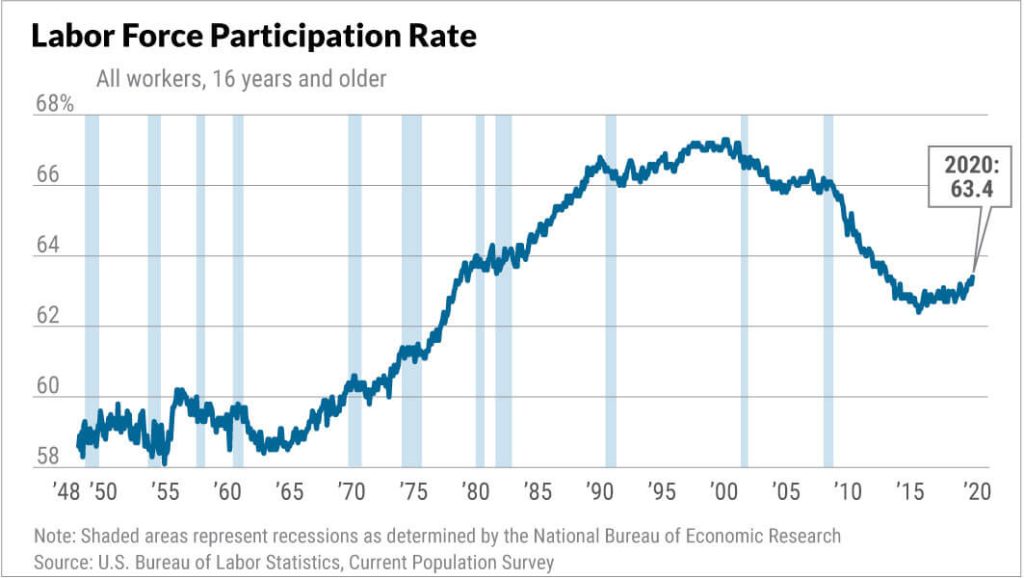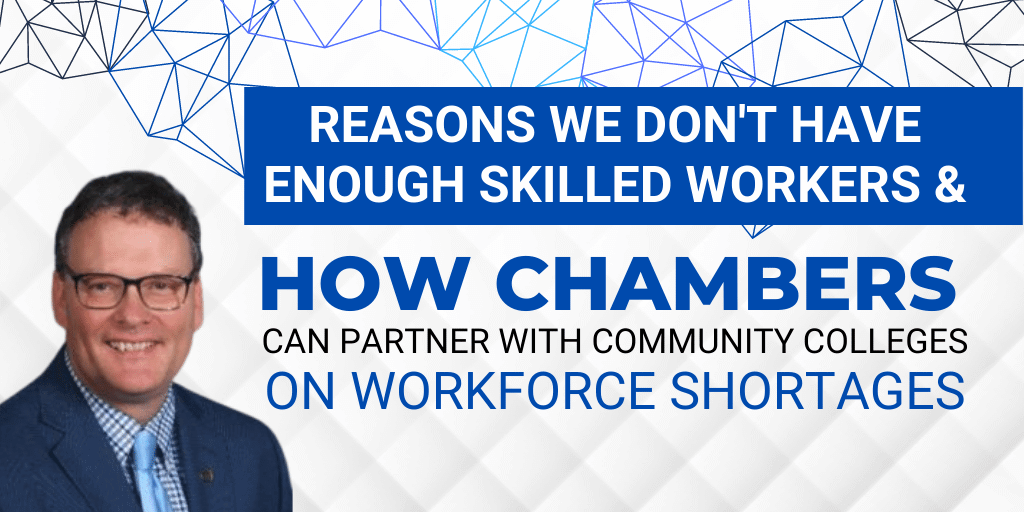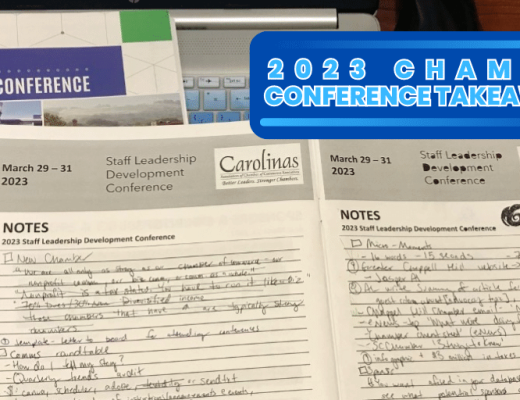Presentation by Dr. John A. Downey, President of Blue Ridge Community College, at the March 2023 Virginia Association of Chamber of Commerce Executives Spring Conference. Reposted with permission, minor revisions made to adapt for blogging.
I have had the honor of working in community college education for over 37 years. I can’t recall a time like we are living in when it comes to workforce trends, community college enrollment trends, and the struggle employers are having finding willing and qualified workers.
If we are to effectively support the efforts of our local Chambers of Commerce in supporting regional economic development, I think it is important for us to get a better understanding of what is causing our current workforce crises, to think ahead of what the workforce may look like a decade from now, and what possible solutions to the declining availability of qualified workers that might help to foster
economic development goals.
Historically, workforce shortages have typically been limited to just a few workforce sectors or just some regions of the state or nation… For example, sometimes regions might report a shortage of trade workers, or a shortage of nurses. But today, we are experiencing unprecedented shortages in almost every employment sector economic developers care about, and employers tell me that they can’t find qualified and skilled workers in virtually every segment of employment that community colleges and other training providers offer training and education in…. everything from truck drivers to teachers, to welders, aviation maintenance technicians, health care workers, hospitality and tourism employees, and even early childhood and K-12 teachers.
These workforce shortages continue to occur despite a relatively longer than usual period in overall low unemployment rates, both nationally and locally.
Unemployment numbers rose dramatically but relatively briefly during COVID. Before and after, they’ve remained below 4% nationally since about 2016, and they are now at about 3.4% nationally, down dramatically from the 6.2% rate two years ago at this time. (Source: Bureau of Labor Statistics, BLS)
In much of Virginia, the unemployment rates have usually been stronger than the national average rates… Typically averaging in the 3% range. The current rate in Virginia is 3.1%, down from the 4.6% rate two years ago.
I have observed that employers sometimes believe that workforce shortages in a given sector can be solved by simply opening up additional training programs in that sector. I think that impulse might be making the problem worse instead of better.
As low unemployment numbers have been persistently low except during COVID, community college associate degree enrollments have also been declining nationally and across Virginia.
Community College Enrollments Declining Despite Economic Patterns
Traditionally, community college degree program enrollments run counter-cyclical with the economy. If the economy is strong, community college enrollments tend to be weaker. If the economy is in a recession, community college enrollments soar, like they did in 2009 and 2010.
However, in the current economy, fewer working-class people have been choosing to go to college, and national community college enrollments have declined in double digit percentages in the last decade, a trend made worse during COVID. This past year, Blue Ridge Community College has seen some encouraging rebounding in enrollment, but statewide numbers suggest we are not indicative of the overall state and national trends.
Given all these data, I began to wonder about the root causes of our workforce challenges. In particular, I was perplexed that if our state unemployment rate is typically so low, why have employers been having so many problems attracting and retaining workers in virtually all segments of the economy, and why are community colleges seeing declining associate degree enrollments in high paying professions where there is such a need for qualified workers?
Why is the US Labor Market Participation rate so low?
In my research, I came across a publication by Lightcast called, the Demographic Drought. (They have since produced a second, updated report as a follow up to that original report). This was the first publication I have seen that attempts to provide a comprehensive explanation for the workforce shortages we have been facing. Subsequently, I’ve seen similar research available from other organizations as well.
The research I am reading about predicts a severe shortage of workers in the coming decades, but also describes many of the reasons for the current labor shortages. Our society appears to be facing a persistent dearth of talented people who are both able and willing to work. Today, I would like to talk briefly about some of these reasons for the decline in workforce ready employees, and then describe some the ways that community colleges like Blue Ridge Community College, are working with employers and other community partners to address these challenges.
First, I mentioned the unemployment rate earlier. But there is actually a better measure of the decline in eligible workers, called the labor market participation rate. The LMPR is defined as the percentage of the overall population that is eligible to work…. and who are actually working.
In the 1990s, the LMPR was about 69%, whereas today it has fallen to only 62%. This statistic begs the question: Why is it that almost 4 out of every 10 eligible workers are choosing not to participate in the labor market?

Here are some of the reasons cited in The Demographic Drought by Lightcast:
Baby Boomers Retiring (at record rates)
First, Baby boomers are now retiring at record rates, a phenomenon that we expected to occur eventually, but which has been accelerated by the pandemic.
Greatest Historical Wealth Transfer
Second, the report points out that many other baby boomers are relatively wealthy compared to previous generations. In fact, financial experts are predicting the greatest transfer of wealth from one generation to another in history in the coming decades. Some experts have speculated that perhaps this transfer of wealth has caused a certain percentage of the younger population to feel that they have less of a need to work than prior generations, especially in the traditional occupations that baby boomers are retiring from. Interestingly, there has been a corresponding rise in entrepreneurialism and small business startups. As more people start new companies and hire more workers, fewer workers are available in more traditional workforce pursuits. We have also seen a rise in non-profit and philanthropic organization startups. All of that may be a factor in the declining availability of traditional workers, but it is really the number of people who are currently not working at all that is the most alarming….
Opioids & Substance Abuse Addiction
One reason for that is substance abuse addiction… especially opioid, fentanyl and meth addiction. In 2015 alone, substance abuse was estimated to account for almost 860,000 fewer men working… a number that explains a 40% of the decline in the LMPR since 1999!
Video Game Addiction
Also stifling men’s participation in the labor market is an increase in leisure pursuits, along with a corresponding increase in video game addiction. By 2015, 21- to 30-year-old males were working 12% fewer hours on average in comparison to the year 2000.
In their 2015 study, Lightcast reported that a whopping 15% of men in this age group did not work even one week for the entire year. This decline in participation correlates highly with a 75% increase in the number of hours this age group participated in leisure pursuits
like video games.
Key demographic: men aged 25-34
All in all, the participation of PRIME AGE MALES in the labor force declined from 94% in 1980, to 89% in 2019. That represents a lot of men not working.
According to a 2014 study, an increasing number of men aged 25-34 were living with parents than with a spouse or significant other. The average age for men getting married increased from 23 in 1960 to 30 in 2019.
Women not returning after COVID shut downs, child care, & other demographic impacts.
There are also a number of factors influencing the decline of women in the labor force. In 2020, fueled by the COVID pandemic, 2.4 million women left the labor market (compared with 1.8 million men). One reason for that decline was that women made up the bulk of the labor force in industries most impacted by COVID shut downs: Retail jobs, the service sector, travel and tourism, and hospitality jobs.
Although most of those jobs have returned by now, many of the female workers did not return to the labor force, because they realized that the long hours and low pay wasn’t helping them to advance financially over time.
In addition, many of the childcare challenges remained post COVID, impacting far more women than men, preventing many women who otherwise might venture back to work from returning.
Birthrate Declines (less young workers than previous generations)
Most significantly, historical BIRTHRATE DECLINES is the other factor accounting for our current workforce challenges. Birthrates that are below 2.1 children per woman, result in the fact that we are not producing enough people to replace those in the workforce who are retiring, dying or otherwise leaving the labor market. In the United States, our current birthrate is about 1.78 children per woman. Notably, it has been below the 2.1 replacement benchmark since the early 1970s.
These are just some of the reasons why we are currently engaging in a war for talent in Virginia and across the country.
Students to Busy Working (& Surviving) to Study Skilled Trades
Indeed, experts view this as a major issue in most industrialized nations. I know employers in my region are feeling the brunt of that talent war currently, as increased wages and sign on bonuses are enticing good employees to leave one job for very similar jobs at a competitors’ company.
Ironically, at Blue Ridge Community College, I also have observed that many of our students are working too much.
Most community college students work multiple jobs while enrolled in school in order to cover the costs of housing, child care, gas and transportation, cell phones and food. Thanks to several generous state and federal subsidies, along with donors who support our work, most students in financial need can now get the sufficient resources to cover the tuition and fees at community colleges in Virginia. Many workforce-oriented associate degree programs are free for students within 400% of the federal poverty level. However, it is all the other life expenses that seem to be overwhelming college students today.
Since most community college students are working while in school, many have difficulty balancing work responsibilities, family life, and the college workload. That difficulty in balancing responsibilities often becomes a recipe for students not finishing courses and degrees and therefore not obtaining the more marketable skills that they need in order to advance in a career in a timely manner.
Too often, working too much instead of concentrating on education and training means that many are not finishing at all with marketable credentials.
Community Colleges a Great Partner for Chamber of Commerce, Economic Development Corporations, & Employers to Address Skilled Labor Needs
Community colleges across Virginia are increasingly partnering with Chambers of Commerce, Economic Development Professionals, employers and with both public and private agencies to address some of these challenges.
Here are some of the ways community colleges are reaching out to address the looming demographic drought:
• Community colleges are now offering a greater number of short term, certification focused, training that takes weeks to complete instead of years.
This segment of community college enrollment has been growing rapidly in Virginia and across the nation. At BRCC, enrollment in our programs like Truck Driving, Welding and short term health care certifications like medical coding, phlebotomy and CAN have risen about 18% in the past year. The Commonwealth of Virginia provides sufficient funding for most students in poverty such that they can attend these training programs free or at minimal cost through programs such as Fast Forward and G3. Your local community college can provide you with details on the benefits available through these two programs.
• Community colleges have also been increasing partnerships with public and private support agencies in order to help our students access “wrap around” support services and resources in the community that can help them stay enrolled in school. These services help our students overcome challenges like food insecurity, housing challenges, and child care issues.
• Colleges have also increased our mental health support services by providing our students with telehealth and other local mental health agency referrals when they become overwhelmed by life circumstances.
• Community Colleges in Virginia also seek out partnerships with other education providers to minimize duplicative services, and to provide employers with the access to workforce training that is so well respected in the community.
Chambers of Commerce can also support Colleges by providing data on emerging business needs, in order to ensure that our educational services are directed towards the emerging careers that are most in demand, that stimulate economic growth, and which help provide a return on the investment our students make in their educational pursuits.
Employers can also help us tremendously by supporting existing education providers that offer training in the workforce sectors that are need, before looking to create their own training programs or services that spread the dwindling pool of available trainees and potential workers even thinner in a workforce region.
Some employers don’t realize that education providers like Blue Ridge Community College can provide customized workforce training services that can be tailored to the specific needs of individual employers. Such training programs can often be offered anywhere, including at the employers own place of employment.
• Community Colleges continue to emphasize the economic value of our excellent transfer education system in Virginia, by showing students if they start with us, they can finish a baccalaureate far less expensively with our partner public and private four-year colleges and universities, and often they can be working in their chosen employment field while completing their degrees. Many people are unaware that nationally, almost half of all baccalaureate degree graduates have started out their college education at a community college!
• Finally, Community Colleges are also seeking innovative partnerships that might help us to provide workforce training and education to workforce populations that may have been overlooked in the past because of their unique challenges. Populations like:
- people with substance abuse disorders
- the immigrant population
- former prison inmates
- or parents in need of childcare as they seek an education.
Chambers of Commerce can support these efforts by helping identify underserved populations of potential workers in a region, and helping employers to access the services we could provide for these populations of people.
National supply chain shortages and slow response times to acquiring basic goods and services will increase if we don’t find ways to address the declining labor market participation rates and the anticipated increase in workforce shortages.
Recommended podcast: Give his interview on ‘Higher Education’s Response to Growing Workforce Needs’ on Enrollment Edge by enrollmentFUEL
About the author: Dr. John A. Downey became the fifth President of Blue Ridge Community College in Weyers Cave, Virginia, in 2009. Downey served on three of the most recent Virginia Community College System (VCCS) strategic planning development committees and chaired the 2021 Strategic Initiatives Task Force. He has served as the chairperson, or as a member, of numerous community boards, including the Shenandoah Valley Partnership for Economic Development, the Blue Ridge Area Food Bank, the Shenandoah Valley Workforce Development Board, the Harrisonburg City Rotary Club, On The Road Collaborative, and the GenEdge Alliance Board of Trustees (formerly the A.L. Philpott Manufacturing Extension Partnership).
Under his leadership, BRCC has garnered recognition from around the state for its progressive workforce initiatives and partnerships. In 2010, he was recognized as the most supportive president of the year at the Enactus (formerly SIFE) National Exposition. Blue Ridge Community College has consistently been recognized throughout the past decade by the Chronicle of Higher Education’s “Great Colleges to Work For” program.



